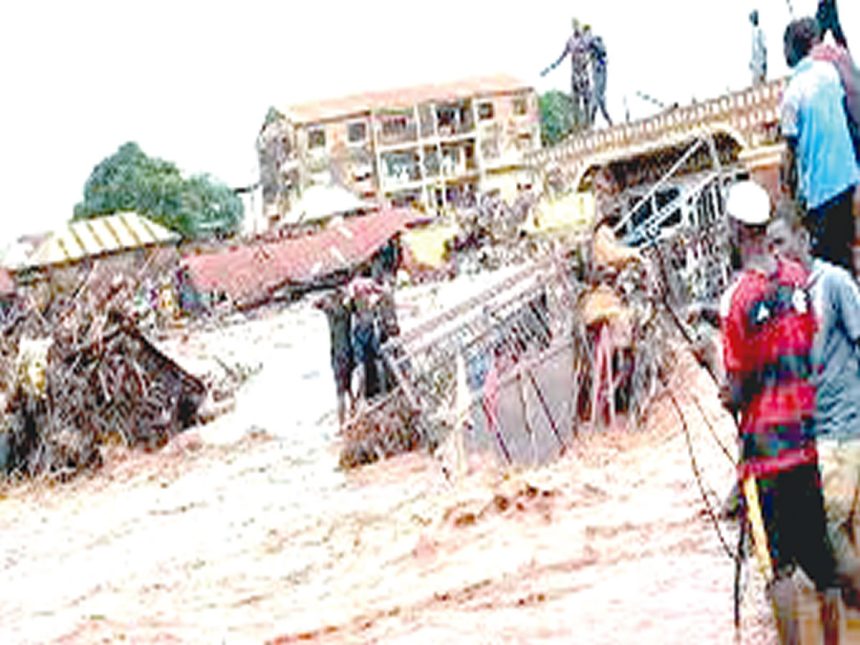While floods pose a growing threat to communities and their financial stability, as exemplified by the recent Mokwa flooding, insurance can be a powerful way to ease the financial shock—if coverage is designed and implemented effectively, writes JOSEPH INOKOTONG.
ON May 28, 2025, catastrophic flooding triggered by heavy rainfall submerged the market town of Mokwa in Niger State, causing extensive damage. According to officials, more than 200 lives were lost, with over 1,000 people still missing and at least 121 injured. The floodwaters destroyed approximately 2,000 homes, displacing hundreds of families.
In the wake of the tragedy, the Niger State government initiated a comprehensive review of the incident, assessing its impact and evaluating the response mechanisms implemented to aid victims and their families.

During a tour of the affected areas, Governor Mohammed Umar Bago, accompanied by his deputy, Yakubu Garba, ordered the immediate evacuation of displaced persons from temporary camps into rented accommodations in Mokwa town. He also approved N1 billion to aid ongoing relief operations. The governor was received by the Etsu Nupe and chairman of the Niger State Council of Traditional Rulers, Alhaji Yahaya Abubakar, alongside Ndalile of Mokwa, the community’s traditional leader.
While assessing the damage, Governor Bago called for repairs to the Nigerian Railway Corporation’s track and bridge and pledged the state’s readiness to provide land and access roads for new housing settlements for the victims’ families. This resettlement, he explained, would be constructed under the state’s Green Economy Initiative, employing climate-informed ecological drainage systems in and around Mokwa.
Additionally, Governor Bago approved the delivery of 50 truckloads of food grains and N15 million in funding for the Rabbah community, where the youth had constructed a temporary bridge following the flood’s destruction. The gesture was warmly received by both the Etsu Nupe and Nda Lile, who recognized its significance in strengthening recovery efforts.
The Permanent Secretary for Environment and Climate Change, Alhaji Idris Usman Gbogan, said the state government was closely collaborating with federal authorities and stakeholders to enable the reclamation of flood-damaged sites in Mokwa and Rabbah. Gbogan also drew attention to the role that deforestation—stemming from extensive charcoal production—had played in exacerbating the flood’s effects.
In its flood review response, the state government called upon Mokwa and Rabbah communities to avoid building on floodplains and coastal areas, and to discontinue the practice of dumping waste into waterways—measures designed to reduce future vulnerability.
While extensive measures have been implemented to aid victims’ recovery, there has been a notable silence on whether any affected families held insurance policies against their losses—a gap that underscores the ongoing vulnerability of many in the community. As Mokwa counts the cost of devastating floods and the government ramps up recovery efforts, it is pertinent to factor in the role of insurance in flood mitigation.
Floods destroy homes, undermine livelihoods, and exacerbate financial vulnerabilities. Insurance can be a crucial tool to reduce these impacts, but its ability to make a measurable difference largely depends on policy design, pricing, and incentives for policyholders and insurers alike.
For homeowners and renters, flood insurance can help protect their properties and belongings from catastrophic damage. Standard homeowners’ or renters’ policies typically cover water damage stemming from broken pipes—but not flooding itself—which is why adding flood coverage is a key consideration. Some insurers enable policyholders to lower their premiums by choosing higher deductibles, adding financial flexibility while retaining protection.
Across the globe, flood insurance and water damage coverage vary by country and provider. Some governments sponsor flood programs, while in other jurisdictions coverage is entirely provided by the private sector. Policyholders are encouraged to speak with their insurers to identify coverage that best meets their needs.
Where flood coverage is unavailable or prohibitively expensive, mitigation measures can make a dramatic difference. Elevating a home above the base flood elevation, adding flood barriers, or employing other protective measures can reduce the risk of catastrophic damage. Furthermore, developing emergency preparedness plans—and retaining sufficient supplies—helps ease the financial shock when flooding occurs.
Government assistance can aid victims in their recovery, offering financial support for repairs or temporary accommodations. Some flood insurance policies may reimburse policyholders for additional living expenses while their homes are rendered uninhabitable, as well as for damage to furniture, appliances, and vehicles. Life insurance may provide additional financial aid in cases of tragedy.
Coverage typically comes with a waiting period—often from a few days up to a full 30—before it becomes effective. Premiums vary based on a range of factors, including the location and elevation of a property, while policy terms typically exclude damage stemming from sewage backup, surface water, or nearby bodies of water.
Insurers can aid policyholders directly—by co-financing risk-reduction measures—or indirectly by offering incentives to policyholders or governments to implement mitigation strategies. Some insurers sponsor awareness campaigns to help homeowners better protect their properties against future floods.
Using risk-based pricing to account for vulnerability and mitigation measures could further foster incentives for policyholders to reduce their own risk, although this approach is not without its obstacles, from a shortage of data on protective measures’ effectiveness to concerns about policy affordability. Some innovative strategies to address these shortcomings include collecting detailed data on protective measures or employing public-private partnerships to enable coverage for high-risk properties at reasonable premiums.
Economic losses stemming from climate-related hazards are already significant and are expected to grow in the future—a reality driven by both climate change and growing vulnerability. Insurance, alongside careful preparedness and policy incentives, can help ease the financial blow for individuals, families, and communities when floods strike.
READ ALSO: Navigating the dynamics of rate cutting in insurance industry: Risks, rewards, and realities